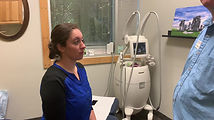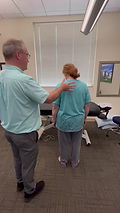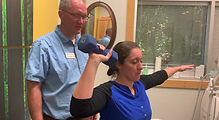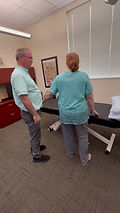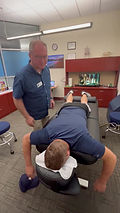Fax #: 801-377-3697


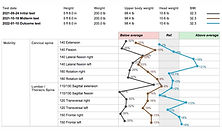
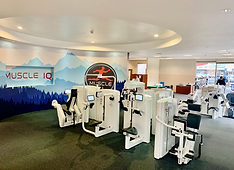
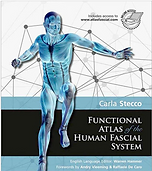
Journal of Muscle IQ
Journal of Muscle IQ - Volume 3
January of 2024
RESEARCH ARTICLE: Low Back Pain Recurrence is Affected by Dysfunctional Multifidus
Journal of Muscle IQ - Volume 3 - January of 2024
Author: Christopher P. Knudsen
Key words: Motor Cortex Inhibition, Paraspinal Muscle Testing, Manual Therapy, Exercise, Physical Therapy
ABSTRACT:
This study will review several studies on the topic of low back pain recurrence and the possible cause being dysfunctional Multifidus.
Some additional concepts being examined are the following:
-
Muscle Pain triggers a decrease in output from the Motor Cortex.
-
Changes in the Morter Cortex can linger even after pain resolves
-
Core Muscles, like the Multifidus, are still weak even after pain resolves.
-
Pain can trigger Cortical weakness in other muscles not related to the pain.
-
Limb perturbations can be used to test for core weakness.
-
Supervised exercise program 3 x week for 8 weeks has lower rates of LBP recurrence than 1 x week for 8 weeks program.
-
Aerobic treadmill workout programs can increase Motor Cortex excitability.
Motor cortex excitability in chronic low back pain - PMC
Chronic Low Back Pain (CLBP) can cause generalized muscle weakness in any muscle in the body because of the changes CLBP causes to the Motor Cortex.
The CLBP group demonstrated higher resting motor threshold (rMT) and lower Intracortical facilitation (ICF) compared to controls, measured in the first dorsal interosseous muscle of the hand. There was no difference compared to controls for Short interval intracortical inhibition (SICI). There may be distinct local and global effects on corticospinal excitability. Local effects may reflect the acute effect of pain, while global effects may indicate long-term adaptation to pain.
The brain was stimulated over the hand motor area on the right using transcranial magnetic stimulation (TMS). This stimulation created signals, motor evoked potentials (MEPs), which were recorded in the left hand.
Transcranial magnetic stimulation (TMS) was applied to the hand motor area of the right hemisphere and motor evoked potentials (MEPs) were recorded from the first dorsal interosseous muscle of the contralateral hand. Resting motor threshold (rMT) and MEP amplitude were measured using single-pulse stimulation. Short interval intracortical inhibition (SICI) and intracortical facilitation (ICF) were assessed using paired-pulse stimulation. Individuals with CLBP had significantly higher rMT (decreased corticospinal excitability) and lower ICF compared to controls.
Predominantly studies have focused on affected muscles (primary location of pain); however, there is some evidence to suggest that changes in excitability may be more generalised. Tagliazucchi et al. (2010) reported that chronic back pain disrupts normal activity across many cortical areas, even in brain resting state, supporting the notion that no single cortical area is responsible for the processing and evaluation of pain. This suggests that altered concentration of GABA and glutamate may reflect more of a global alteration in cortical excitability that is not purely restricted to the region representing the painful muscle (Parker et al. 2016).
This is the first study to show decreased ICF in people with CLBP compared to pain-free controls.
In comparison with other CLBP studies, the present findings did not indicate any changes in inhibition (SICI). This discrepancy may be related to the target muscle examined (e.g., lumbar multifidus muscles vs. FDI). One possibility is that there may be distinct local and global effects on corticospinal excitability. Local effects may reflect the acute effect of pain, while global effects may indicate long-term adaptation to pain.
https://synapse.koreamed.org/articles/1149780
Trunk Muscles Strength as a Risk Factor for Nonspecific Low Back Pain: A Pilot Study
In conclusion, this study was a pilot study which evaluated the risk factor for nonspecific LBP. Our results indicate that an incidence of LBP is associated with isometric and isokinetic trunk extensor weakness and LBP severity is associated with isokinetic trunk extensor and flexor weakness and isometric trunk extensor and flexor weakness. Paraspinal muscle weakness in asymptomatic subjects can lead to an increase of LBP incidence and severity. Age and sex are not modifiable risk factors, but the strength of the trunk muscles is modifiable and can be improved by exercise of the paraspinal muscles. Thus, early strengthening exercises of the paraspinal muscles are necessary to decrease the LBP incidences and severity.
Why do some patients keep hurting their back? Evidence of on... : PAIN
Deep fibers of the Multifidus are slower to contract in patients with a history of recent unilateral LBP vs healthy participants. Short fibers were active earlier than long fibers in healthy participants and on the non-painful side in the LBP group.
Intramuscular and surface electrodes recorded the electromyographic activity (EMG) of the short and long fibres of the lumbar multifidus and the shoulder muscle, deltoid, during a postural perturbation associated with a rapid arm movement.
Activity of deep back muscles is different in people with a recurrent unilateral LBP, despite the resolution of symptoms. Because deep back muscle activity is critical for normal spinal control, the current results provide the first evidence of a candidate mechanism for recurrent episodes.
Even between symptomatic episodes, young individuals with a history of low back pain demonstrated altered recruitment of the deep fibers of the lumbar multifidus in response to changing locomotor speed during walking turns.
Taken together, the results from the present and previous studies suggest that changes in recruitment of the deep fibers of the multifidus persist between painful episodes in individuals with a history of LBP. The differences between groups in the present study were small. However, it is striking that changes in recruitment were still evident in a majority of young, asymptomatic individuals with a history of LBP, who had minimal disability, low levels of fear avoidance, and high self-efficacy.
In conclusion, in this study, subjects with and without LBP performed a unilateral simulated weight-bearing task while ultrasound imaging was used to monitor the TrA and IO muscles. Subjects with LBP showed significantly less shortening of the TrA muscle and greater increases in the thickness of the IO muscle during the simulated weight-bearing task, but there was no significant difference between groups for changes in TrA muscle thickness.
Exercise Is Medicine, But Perhaps Not for Preventing Low Back Pain: A Randomized Trial of Exercise and Education to Prevent Low Back Pain Recurrence
Participants were randomized to receive either 12 weeks of exercise and education (8 supervised exercise sessions and 3 one-on-one sessions) or a control (education booklet). The exercise program was implemented through 8 supervised group-based exercise sessions over 8 weeks (1 session per week), supplemented by a home exercise program to be completed at least twice a week. One-on-one appointments at weeks 4, 8, and 12 were used to monitor progress and adjust the program as needed. Education covered spinal anatomy and kinesiology, LBP risk factors, and why exercise and physical activity are good for LBP. (This study had worse results than a previous study). A difference is that our program had a shorter duration than that of previous trials (eg, 20 sessions over 12 weeks with sessions twice a week in the first 7 weeks).20,25 However, whether the duration reduced the effectiveness of our intervention is unknown, … Adherence to our program was low (55%),
The objective was to evaluate the effectiveness of a group-based progressive strength training program in non-specific chronic LBP (CLBP) patients in primary care on pain recurrence and physical function. Eighty-five patients with non-specific CLBP were separated into two groups (Intervention group: completed a progressive strength training program 3 days per week for 8 weeks. Control group: received the usual care). The intervention group showed a recurrence rate of 8.3%, while the control group had a recurrence rate of 33.3% and a shorter time until the first recurrent episode. The intervention group showed increased lumbar extensor strength, left-hand handgrip strength, and reduced the number of pain sites compared with the control group. Results also showed greater odds for reducing LBP intensity and disability in the intervention group. In conclusion, a group-based progressive strength training program is a more effective and efficient alternative than Back-School programs and can easily be carried out in the primary health care context.
Excitability of the motor cortex can be suppressed during muscle pain.
This article provides evidence for decreased intracortical facilitation and increased short interval intracortical inhibition in response to muscle pain. This finding is relevant to clinicians as a mechanism which may underlie restricted movement in acute and chronic pain.
SICI was increased following pain, but not during.
ICF was decreased both during and after pain when compared with the pre-pain condition.
New Insight into the Time-Course of Motor and Sensory System Changes in Pain - PMC
This study is the first to demonstrate a similar temporal profile of reduction in S1 processing and corticomotor output in association with acute muscle pain.
Notably, pain severity was not associated with the magnitude of the reduction in S1 excitability or corticomotor output, suggesting that the presence of pain, regardless of severity, is sufficient to drive alterations in these parameters.
In a previous study, the electrical nerve stimulation used in stimulating the skin, abolished the reduction in ICF, and thus the reduction in corticomotor output during pain.
These data suggest S1 processing and corticomotor output may be co-modulated in association with muscle pain. Unexpectedly this study provides evidence of a similar temporal profile of altered processing in S1 and reduced corticomotor output in response to muscle pain. Both parameters began to reduce almost immediately after pain reached 5/10.
The present study clearly demonstrated pain relief by tactile input at the spinal and cortical level, showing the spatiotemporal signature of tactile-induced analgesia. Pain–tactile interaction at the cortical level was investigated using carefully timed sensory modality-specific stimuli, in combination with cortical source-based neuromagnetic analysis. We were able to clearly distinguish source location from pain and tactile inputs associated with natural-touch like sensation. Our study clearly demonstrates that the spatial feature of cortical modulation by nociceptive input was different compared with spinal modulation.
The most novel findings were that weaker seniors exhibited: (i) a 20% deficit in voluntary activation; (ii) ~20% smaller motor-evoked potentials during the 30% contraction task; and (iii) nearly twofold higher levels of long-interval intracortical inhibition under resting conditions. This finding contributes to the growing body of literature reinforcing the role of the motor cortex as a key contributor to muscle strength/weakness, which is an extension beyond the more historically viewed scope in movement coordination and skill acquisition. Accordingly, these findings indicate the need for scientists and clinicians to consider neurological mechanisms as key contributors to weakness in older adults and to identify rational strategies to enhance neurological function in older adults.
Effect of Core Strength on the Measure of Power in the Extremities
In sports, muscular demands vary greatly from athlete to athlete. This makes it very difficult to have 1 statement that will address all superiorities or inadequacies of the core. Currently, plank exercises are considered an adequate method of training the core for athletes to improve core strength and stability. The problem with these exercises is that they put the athletes in a nonfunctional static position that is very rarely replicated in the demands of sport-related activities. To train for the majority of sports, it requires a dynamic motion. According to the results of this study, it is recommended to train the lateral aspects of the core with specific dynamic exercises. The anterior and posterior aspects of the core are likely to be trained in conjunction with other sport-specific training—particularly closed chain kinetic exercises. Athletes play dynamically and should be trained dynamically.
Pain-related modulation of the human motor cortex
Pain is able to inhibit the motor cortex. This motor cortex inhibition may act as a sort of motor 'decerebration' so as to allow the spinal motor system to freely develop protective responses to noxious stimulation.
Results supported three relevant findings in people with rLBP when compared to a control group. (i) Motor behaviour was characterised by a greater co-contraction of trunk muscles, with a bias toward preferentially recruiting superficial muscles; (ii) motor control changes involve a redistribution of activity within and between muscles; (iii) delayed activity of deep muscles (MF, TrA, and OI) during a postural task. In relation to changes in deeper muscle activity, deep multifidus (dMF) activity was reduced
The timing of recruitment of deep trunk muscle is delayed in people with rLBP and this may therefore potentially play a role in the development of pain recurrence.
Consistent onset delay was found in the TrA, OI and MF (short fibres) during limb movements.
compared to the activity of the superficial fibres (sMF), with some authors arguing that the modulation of the latter is to compensate for the deficit of the former [56, 57]. Such mechanism could explain the inconsistency reported when MF is assessed with ultrasound or intramuscular EMG (iEMG), as iEMG allows to discriminate the behaviour of sMF and dMF while MF thickness change investigated with US could be biased by sMF [56, 57]. Regardless, evidence agrees that the timing of recruitment of deep trunk muscle is delayed in people with rLBP and this may therefore potentially play a role in the development of pain recurrence. Consistent onset delay was found in the TrA, OI and MF (short fibres) during limb movements [51, 57, 65]. Central nervous system adaptations (e.g. in motor planning), has been suggested as possible mechanism for these changes [73, 74]. Although participants were assessed when asymptomatic, previous painful episodes could have triggered motor strategies involving en masse recruitment possibly due to motor cortex reorganisation [75, 76]. For instance, motor region “smudging” was reported in people with a history of LBP and altered muscle recruitment during postural perturbations [74, 76, 77]. Specifically, the motor cortical areas of deep MF and longissimus erector spinae were overlapped in people with rLBP [76, 77]. Similar findings were reported also assessing neck muscles, but only in people with chronic NP [78].
https://www.sciencedirect.com/science/article/abs/pii/S0003999316309030
This study confirms that older adults with chronic LBP have worse self-reported and performance-based physical function when compared with their peers without LBP. This study, however, is among the first to specifically evaluate lumbar multifidi intramuscular fat as it relates to physical function among older adults. Our hypotheses are supported; multifidi intramuscular fat may help to explain both self-reported and performance-based physical function among older adults with chronic LBP.
Reduced thoracolumbar fascia shear strain in human chronic low back pain
